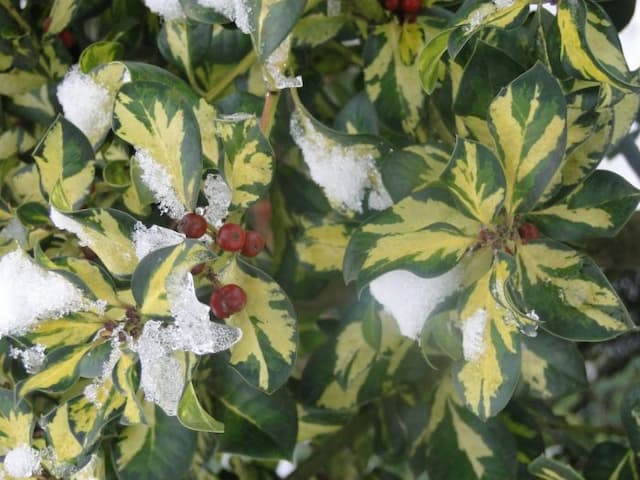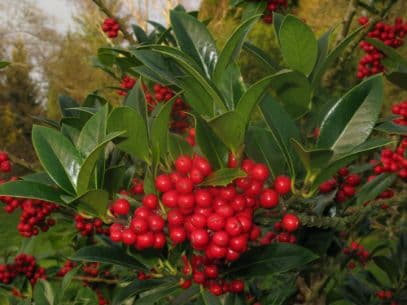English Holly Ilex aquifolium 'Pyramidalis' (f)

ABOUT
The plant in question is commonly known as the 'Pyramidalis' English Holly. This variety features a distinctive pyramidal shape, giving it a conical or tapered appearance. Its leaves are a glossy, deep green color, and they flaunt the classic holly shape with spiny, serrated edges. The foliage is dense, which contributes to its lush, evergreen presentation throughout the year. As a female cultivar, 'Pyramidalis' produces bright red berries that are not only attractive but also serve as food for birds during the winter months. These berries contrast beautifully against the dark green leaves, creating a festive look commonly associated with the holiday season. The plant's leaves and berries are often depicted in Christmas decorations and iconography. Its overall form and features make it a popular choice for ornamental gardening, providing year-round interest and texture to landscapes.
About this plant
 Names
NamesFamily
Aquifoliaceae.
Synonyms
English Holly, European Holly, Christmas Holly.
Common names
Ilex aquifolium 'Pyramidalis' (f).
 Toxicity
ToxicityTo humans
The plant in question is commonly known as the English Holly. The English Holly is considered to be toxic to humans if ingested. The berries and leaves contain several toxic substances, including theobromine, an alkaloid that is similar to caffeine, and ilicin. Symptoms of poisoning from consuming parts of the English Holly include nausea, vomiting, diarrhea, and abdominal pain. In severe cases, it can also cause drowsiness, dehydration, and in extreme cases, it can be fatal if sufficient quantities are consumed. It is especially important to keep children away from the berries, as they can be attractive but are potentially dangerous if eaten.
To pets
The plant known as English Holly is toxic to pets. Ingesting the leaves or berries can lead to symptoms of poisoning in animals such as dogs and cats. These symptoms include vomiting, diarrhea, drooling, and a decrease in energy. Consumption of a large amount of the plant can be more severe, potentially leading to dehydration, drowsiness, and in extreme cases, it can be fatal. Pet owners should prevent their animals from eating any parts of the English Holly plant to avoid these dangerous health issues.
 Characteristics
CharacteristicsLife cycle
Perennials
Foliage type
Evergreen
Color of leaves
Green
Height
6-10 feet (1.8-3 meters)
Spread
4-6 feet (1.2-1.8 meters)
Plant type
Shrub
Hardiness zones
5-9
Native area
Europe
Benefits
 General Benefits
General Benefits- Ornamental Value: Ilex aquifolium 'Pyramidalis', commonly known as English Holly, has glossy, spiny leaves and a structured, pyramidal shape that make it an attractive ornamental plant.
- Wildlife Habitat: The plant produces red berries that provide food for birds and other wildlife during autumn and winter months.
- Privacy Screen: Due to its dense growth, English Holly can be used to create a privacy screen in gardens or landscapes.
- Evergreen Foliage: It retains its foliage year-round, providing continuous greenery and interest in gardens, especially in the winter months.
- Topiary and Hedging: English Holly is suitable for shaping into topiary or hedging, offering landscapers and gardeners creative design options.
- Drought Tolerance: Once established, the plant has some tolerance to drought, reducing the need for frequent watering.
- Adaptability: It is capable of adapting to a range of soil types, although it prefers well-drained, slightly acidic soils.
 Medical Properties
Medical Properties- This plant is not used for medical purposes.
 Air-purifying Qualities
Air-purifying QualitiesThis plant is not specifically known for air purifying qualities.
 Other Uses
Other Uses- As a natural dye: The leaves and berries of the holly can be used to create natural dyes for fabric and craft projects.
- In woodworking: The hardwood of holly is often used for intricate inlays and decorative elements in fine furniture.
- As a coffee substitute: During times of hardship, the roasted leaves have been used to make a caffeine-free coffee alternative.
- For privacy hedging: Due to its dense, prickly foliage, holly hedges are effective natural barriers that deter animals and unauthorized access.
- In festive decorations: Branches are used to make Christmas wreaths and to add greenery to holiday arrangements.
- As a protective charm: In some cultures, planting holly around the home is believed to offer protection against evil spirits and lightning.
- In bird gardens: Holly provides shelter and winter berries for birds, making it an ideal plant for wildlife-friendly landscapes.
- As a symbol in heraldry: Holly is used in heraldic emblems and family crests to symbolize truth and resilience.
- In winter gardens: Holly's evergreen leaves and bright red berries provide color and interest in otherwise bare winter landscapes.
- In cultural celebrations: Holly plays a significant role in various cultural rites and celebrations throughout the world.
Interesting Facts
 Feng Shui
Feng ShuiThe plant Holly is not used in Feng Shui practice.
 Plant Symbolism
Plant Symbolism- Protection: Ilex aquifolium, commonly known as Holly, has been symbolically associated with protection due to its spiky leaves. It was believed to ward off evil spirits and negative energies.
- Good Fortune: Holly is often considered to bring good luck and is used in celebrations such as Christmas to invite prosperity and good fortune into the home.
- Fertility: With its robust growth and evergreen nature, holly represents fertility and eternal life.
- Hope: The ability of holly to stay green throughout the winter months makes it a symbol of hope and the enduring nature of life.
- Peace: In some cultures, holly is seen as a symbol of peace and goodwill, particularly during the holiday season when it is commonly displayed.
 Water
WaterEnglish Holly 'Pyramidalis' should be watered thoroughly when the top inch of the soil feels dry to the touch, typically once or twice a week depending on weather conditions. It's important to provide deep watering to encourage root growth, which may mean using about 1-2 gallons of water for a young plant and increasing the amount as the plant grows, ensuring not to oversaturate the soil. During the winter months or rainy periods, reduce watering frequency to prevent root rot. Always check the soil moisture before watering to avoid overwatering.
 Light
LightEnglish Holly 'Pyramidalis' prefers full sun to partial shade. The best spot for this holly is an area where it can receive at least 4-6 hours of direct sunlight per day, although it can tolerate some shade. Avoid deep shade as it may lead to less dense growth and fewer berries.
 Temperature
TemperatureEnglish Holly 'Pyramidalis' is hardy in a range of temperatures and can survive minimum temperatures down to about 0 to -10 degrees Fahrenheit. It thrives in a climate with seasonal changes and prefers an ideal temperature range between 50 to 70 degrees Fahrenheit. Extreme heat above 90 degrees Fahrenheit may stress the plant.
 Pruning
PruningEnglish Holly 'Pyramidalis' should be pruned to maintain its shape and to remove any dead or damaged branches. The best time for pruning is late winter or early spring before new growth begins. It may also be pruned lightly throughout the year to shape as desired. To encourage berry production, minimal pruning is generally recommended.
 Cleaning
CleaningAs needed
 Soil
SoilEnglish Holly 'Pyramidalis' flourishes in well-drained, loamy soil with a pH between 5.0 and 6.0. A mix containing one-third peat, one-third sand, and one-third garden loam is ideal. Mulch to maintain moisture.
 Repotting
RepottingEnglish Holly 'Pyramidalis' should be repotted every 2-3 years, in spring, to manage growth and renew the soil.
 Humidity & Misting
Humidity & MistingEnglish Holly 'Pyramidalis' is tolerant of a wide range of humidity levels but prefers moderate humidity, without the need for specific adjustments.
 Suitable locations
Suitable locationsIndoor
Place in bright indirect light, water when topsoil is dry.
Outdoor
Plant in partial shade, shelter from strong winds, mulch well.
Hardiness zone
6-9 USDA
 Life cycle
Life cycle'Pyramidalis' is a female cultivar of the common holly (Ilex aquifolium). The life of this evergreen shrub begins with seed germination, which requires a period of cold stratification to break dormancy. After sprouting, the seedling grows slowly, developing spiny, glossy green leaves and a strong root system. It reaches maturity in several years, at which point it begins to produce small, white flowers in late spring that are pollinated by insects. If a male holly is nearby to provide pollen, the flowers give way to red berries in the fall, which persist into winter and are a food source for birds. Holly can live for many decades, often exceeding 100 years, with a pyramidal growth habit that can reach heights of 6-10 meters (about 20-33 feet).
 Propogation
PropogationPropogation time
Early Spring
Propogation: The most popular method of propagating Ilex aquifolium 'Pyramidalis', commonly known as the English Holly, is through softwood cuttings. This process is usually done during the late spring or early summer when the new growth is still soft and pliable. Cuttings should be about 4 to 6 inches long, with the lower leaves removed. It's important to dip the cut end of the cuttings in a rooting hormone to encourage root development. Then, the cuttings are placed in a well-draining potting medium and kept under high humidity and indirect light until roots have developed. This can take several weeks, and during this time, the cuttings should be kept out of direct sunlight and watered regularly to maintain consistent moisture.









